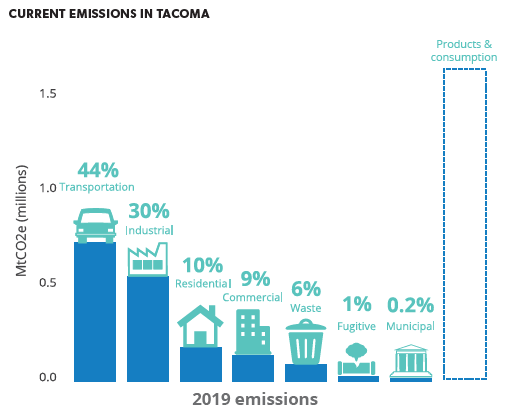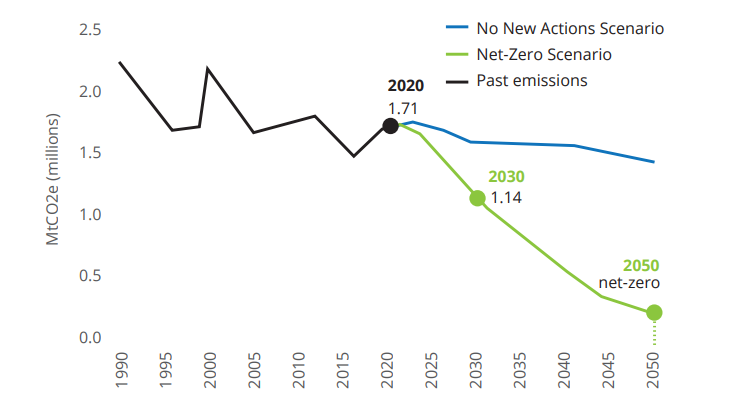A landmark August 2021 United Nations report calls for more aggressive climate action, describing 2021 as a “make-or-break year” to make investments to avoid irreversible, catastrophic climate change.
Tacoma’s Climate Action Plan (CAP) urgently responds to our climate emergency by proposing 64 climate actions with a deadline of 2024 to address the largest sources of community greenhouse gas (GHG) emissions, including consumption, transportation, industry, and buildings, as well as prepare for local climate impacts, such as wildfire smoke, extreme heat, and sea level rise.
Learn more about the City's Energy & Emissions Modeling Results in our 2030 Climate Action Plan.
Greenhouse Gas Emissions Monitoring
The Office of Environmental Policy & Sustainability, in partnership with the Sustainable Tacoma Commission, monitors greenhouse gas reductions and sustainability efforts made by the City of Tacoma and the community.
The Greenhouse Gas Inventory and Business as Usual Scenario Report 2019 takes inventory of the current levels of greenhouse gas (GHG) emissions within the City of Tacoma limits. The "sector" based inventory only includes pollution generated here in Tacoma, that is predominately fossil fuels burned here.
City of Tacoma's Community Emissions by Sector in 2019
For 2019, Tacoma's GHG pollution amounted to approximately 1.7 million metric tons of carbon dioxide equivalent emissions (MtCO2e), or 7.7 MtCO2e per person. Similar to past years, transportation remains the largest source of GHG emissions, accounting for 44% of GHG pollution from fossil fuels burned by cars, buses, trains, and trucks. Industrial processes account for 30% of emissions according to the graph below. However, this assessment is only the GHG pollution that was created within the City of Tacoma. If we were to include GHG pollution from items produced outside Tacoma that we buy to eat or use, our GHG pollution would nearly double, accounting for the Products & Consumptions portion of the bar graph below.

Tacoma's 2019 emissions comes from actual reported emissions data, as well as modelled data (i.e. downscaling Tacoma emission based on national or regional data or surveys).
City of Tacoma 2050 Emission Reduction Target

Since 2005, our carbon pollution has generally and modestly trended downward, although the dip in 2016 was mostly due to significant natural gas decreases in our industrial area. Based on the City of Tacoma's past emissions, the green line on the graph above depicts the future prediction of what the City's emissions would look like if no new actions were taken. This is often called a No New Action (NNA) scenario. Tacoma's current NNA scenario does include projected population growth and shows that our emissions would drop 14% by 2050 based on already existing plans and policies. This moves us in the right direction, but is not steep enough to avoid unacceptable climate impacts on our community.
Our City Council has agreed that planning around the Paris Climate Accord goal of net zero carbon by 2050 is the most prudent and equitable path forward. Scientists now agree that in order to keep our planet to below 2 degrees Celsius of warming, net emissions need to be zero by 2050. This gives us a chance of allowing our planetary systems to right themselves. Beyond 2 degrees, irreversible feedback loops would likely keep escalating warming and worldwide ecosystems, ocean and jet streams, forests dying and burning, irreversible loss of Greenland ice sheets, and ocean acidification.
This gap between the dark blue line and the light green line shows the difference between where we would be without new action and where we need to be to reach our goals. It shows the transformative scope and pace necessary. It should be stressed, that while this gap from -14 to -100% is significant, reaching this goal is not solely the responsibility of the City of Tacoma. This is a community-wide goal and we cannot get there without state and federal support and actions, as well as investments and changes by our local partners and businesses.
For more information about the City of Tacoma's past Greenhouse Gas inventory and Emissions Update, review the reports below:
Greenhouse Gas Emissions Update Report 2016
Greenhouse Gas Inventory Presentation 2016
Greenhouse Gas Emissions Update Report 2012